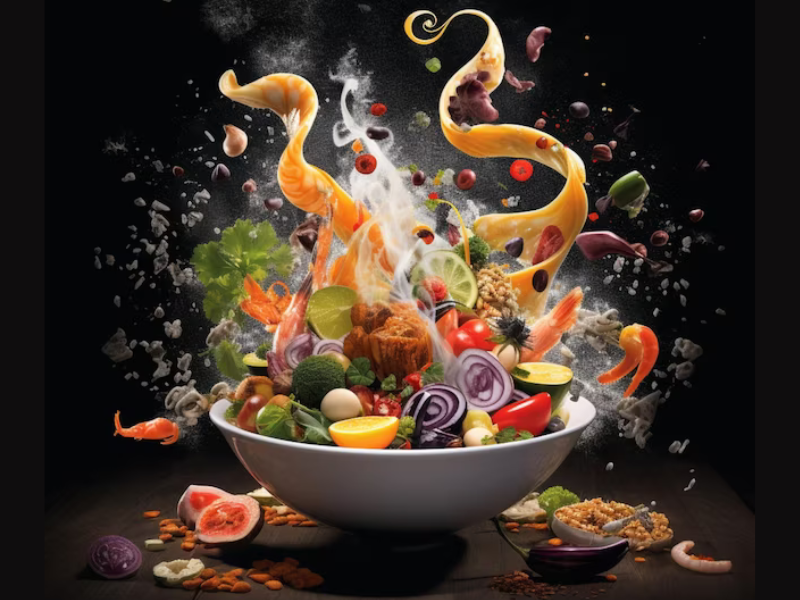The Evolution of American Cuisine: From Colonial Times to Present Day
Introduction
American cuisine has evolved significantly over the centuries, drawing influences from various cultures and regions to create a diverse and dynamic food culture. From the simple and utilitarian meals of early colonial settlers to the vibrant and eclectic dishes of present-day America, the evolution of American cuisine tells the story of a nation shaped by immigration, innovation, and adaptation. In this article, we will explore the key moments in the history of American cuisine, tracing its development from colonial times to the present day.
Colonial Era (1600s-1700s)
The cuisine of early American settlers was heavily influenced by the ingredients and cooking techniques of their native countries, primarily England, as well as by the food traditions of Native American tribes. Simple, hearty dishes such as stews, cornbread, and pies were common fare, utilizing local ingredients like corn, beans, and game meat. The lack of refrigeration and modern cooking technology meant that food preservation techniques such as salting, smoking, and pickling were essential for survival.
The Influence of Immigration
As waves of immigrants from Europe and other parts of the world began to arrive in America in the 19th and early 20th centuries, they brought with them their own culinary traditions and ingredients. Italian, Mexican, Chinese, and Jewish immigrants, among others, introduced new flavors and cooking techniques to American cuisine, forever changing the culinary landscape of the country.
The Rise of Southern Cuisine
Southern cuisine, with its roots in African, Native American, and European culinary traditions, emerged as a distinct and influential style of cooking in the American South. Staples such as collard greens, fried chicken, and cornbread became emblematic of Southern cuisine, showcasing the region’s rich history and diverse cultural influences.
The Influence of Industrialization
The advent of industrialization in the late 19th and early 20th centuries brought with it significant changes to American food production and consumption. Canned goods, processed foods, and fast food restaurants became increasingly popular, leading to a shift towards convenience and efficiency in cooking. While these innovations made food more accessible and affordable, they also led to concerns about the quality and nutritional value of the American diet.
The Rise of the Food Movement
In response to the industrialization of food production, the food movement emerged in the mid-20th century, advocating for sustainable agriculture, local sourcing, and organic farming practices. Pioneers such as Alice Waters, founder of Chez Panisse, and Michael Pollan, author of “The Omnivore’s Dilemma,” helped to popularize the idea of “eating local” and supporting small-scale producers.
The Influence of Television
The rise of television in the mid-20th century had a profound impact on American cuisine, bringing cooking shows and celebrity chefs into the mainstream. Personalities like Julia Child, Emeril Lagasse, and Rachael Ray helped to popularize cooking as a form of entertainment, inspiring home cooks across the country to experiment with new recipes and techniques.

The Rise of Fusion Cuisine
As America became an increasingly multicultural society in the late 20th and early 21st centuries, fusion cuisine emerged as a popular culinary trend, blending elements of different culinary traditions to create innovative and eclectic dishes. Restaurants like Momofuku in New York City and Kogi BBQ in Los Angeles helped to popularize the fusion food movement, inspiring chefs and home cooks alike to experiment with new flavor combinations.
The Local Food Movement
In recent years, the local food movement has gained momentum, with consumers increasingly seeking out locally sourced, sustainably produced foods. Farmers’ markets, community-supported agriculture (CSA) programs, and farm-to-table restaurants have become increasingly popular, reflecting a growing interest in supporting small-scale producers and reducing the environmental impact of food production.
The Influence of Technology
Advances in technology have had a profound impact on the way we produce, distribute, and consume food. The rise of social media, food delivery apps, and meal kit services has transformed the way we think about cooking and dining, making it easier than ever to access a wide variety of cuisines and ingredients from around the world.
The Rise of Plant-Based Cuisine
In recent years, plant-based cuisine has surged in popularity, with more Americans opting for vegetarian and vegan diets for health, ethical, and environmental reasons. Plant-based restaurants and products have become increasingly mainstream, offering a wide range of innovative and delicious options for those looking to reduce their consumption of animal products.
The Influence of Celebrity Chefs
The rise of celebrity chefs like Gordon Ramsay, Bobby Flay, and Ina Garten has transformed the culinary landscape of America, bringing a new level of glamour and excitement to the world of food. These larger-than-life personalities have inspired a new generation of home cooks and food enthusiasts, encouraging them to explore new ingredients, techniques, and cuisines.
The Impact of Globalization
Globalization has had a major impact on American cuisine, bringing a diverse array of flavors and ingredients from around the world to our doorstep. The popularity of international cuisines such as sushi, tacos, and curry reflects the increasingly cosmopolitan tastes of American consumers, who are constantly seeking new and exciting culinary experiences.
The Future of American Cuisine
As America continues to evolve and change, so too will its cuisine. The future of American food will likely be shaped by a combination of factors, including changing demographics, environmental concerns, technological advancements, and cultural influences. One thing is certain: American cuisine will continue to be a vibrant, diverse, and constantly evolving reflection of the nation itself.
Conclusion
The evolution of American cuisine is a rich and complex story, shaped by centuries of immigration, innovation, and adaptation. From the simple and utilitarian meals of early colonial settlers to the vibrant and eclectic dishes of present-day America, the culinary history of the United States is a testament to the country’s diversity and creativity. As we look towards the future, one thing is clear: American cuisine will continue to evolve and change, reflecting the ever-changing tastes and preferences of the American people. Whether you prefer traditional comfort foods or cutting-edge fusion cuisine, there is something for everyone in the ever-expanding world of American food.
FAQs about “The Evolution of American Cuisine: From Colonial Times to Present Day”
- What makes “The Evolution of American Cuisine: From Colonial Times to Present Day” a compelling exploration of American food history? This book offers a fascinating journey through the evolution of American cuisine, tracing its roots from colonial times to the present day. It provides insights into the cultural, social, and economic factors that have shaped American foodways over the centuries.
- Which periods of American history are covered in this book? “The Evolution of American Cuisine” covers a wide range of periods in American history, including the colonial era, the Revolutionary War, westward expansion, the Industrial Revolution, immigration waves, and modern culinary trends.
- Are specific dishes or culinary trends highlighted in this culinary history? Yes, “The Evolution of American Cuisine” features a variety of iconic dishes, cooking techniques, and culinary trends that have defined American gastronomy throughout history. Readers will learn about the influences of Native American, African, European, Asian, and Latin American cuisines on American cooking.
- How does this book showcase the cultural diversity of American cuisine? This book showcases the cultural diversity of American cuisine by exploring the contributions of various ethnic and regional food traditions to the American culinary landscape. It celebrates the melting pot of flavors and ingredients that have enriched American food culture.
- Can readers expect to gain insights into the impact of historical events and social changes on American food habits? Absolutely! “The Evolution of American Cuisine” delves into the impact of historical events, social changes, technological advancements, and demographic shifts on American food habits. Readers will gain a deeper understanding of how American cuisine has adapted and evolved over time in response to changing circumstances and tastes.
Advantages:
- Historical perspective: The title “The Evolution of American Cuisine: From Colonial Times to Present Day” suggests a comprehensive exploration of the development of American food culture over time, providing readers with insights into the historical, cultural, and social factors that have shaped American cuisine.
- Cultural immersion: By tracing the evolution of American cuisine, the title offers readers a deeper understanding of American culinary traditions, regional specialties, and the diverse influences that have contributed to the rich tapestry of American food culture.
- Gastronomic exploration: Readers can anticipate learning about a variety of dishes, ingredients, and cooking techniques that have defined American cuisine throughout different historical periods, providing them with a comprehensive overview of American culinary heritage.
- Practicality: By focusing on the evolution of American cuisine, the title appeals to readers interested in exploring authentic and traditional American dishes, offering them historical context and insights to appreciate the origins and development of American food culture.
- Inspiration for cooking: The title may inspire readers to explore historical American recipes or attempt to recreate traditional dishes from different time periods, encouraging culinary exploration and appreciation of American culinary heritage.
Disadvantages:
- Potential oversimplification: Tracing the evolution of American cuisine in one title may oversimplify the complexity and diversity of American food culture, overlooking regional variations and cultural nuances.
- Limited coverage: The title may not cover every aspect of American culinary history in depth, potentially leaving out certain periods or culinary influences that are of interest to some readers.
- Interpretation bias: The title may present a specific interpretation of American culinary history that may not align with every reader’s perspective or understanding of American food culture.
- Lack of specificity: The title does not specify which dishes, ingredients, or historical periods will be explored, leaving readers uncertain about the scope of the content.
- Cultural appropriation: Without proper context and understanding, tracing the evolution of American cuisine could risk appropriating cultural elements without acknowledging their significance or respecting their origins.
















